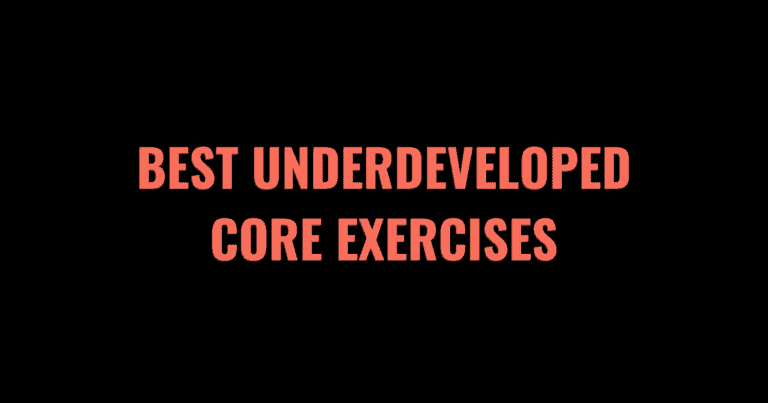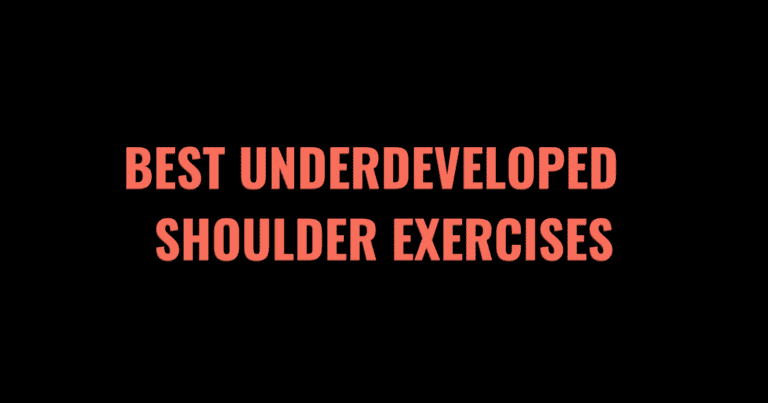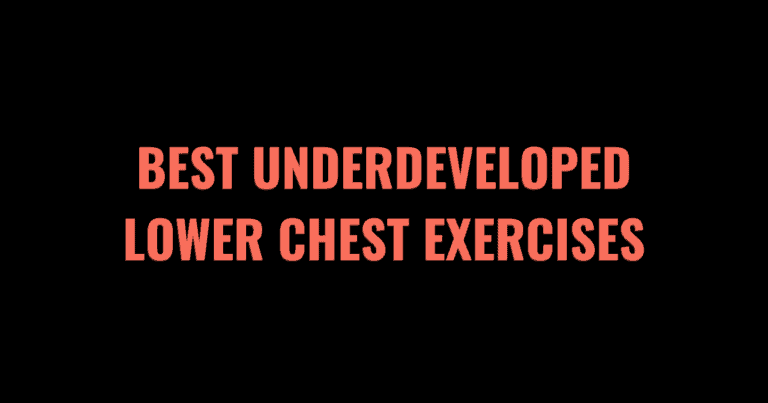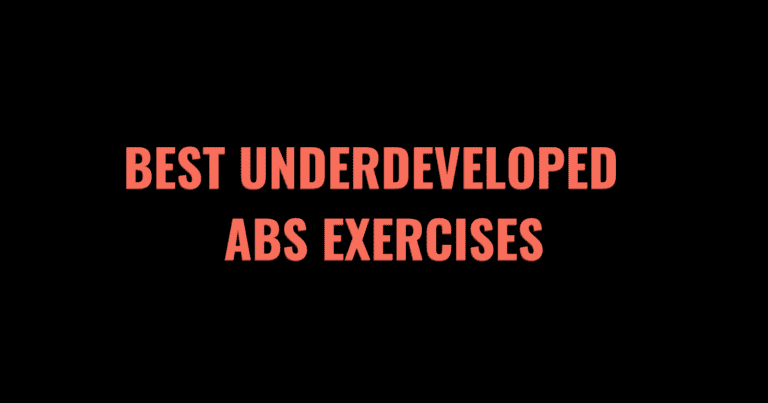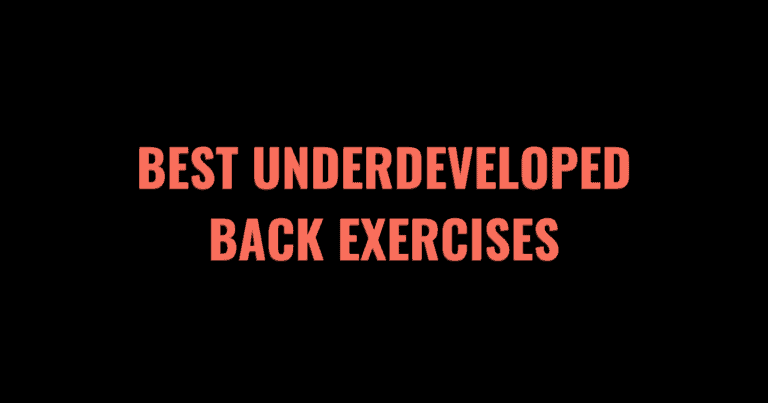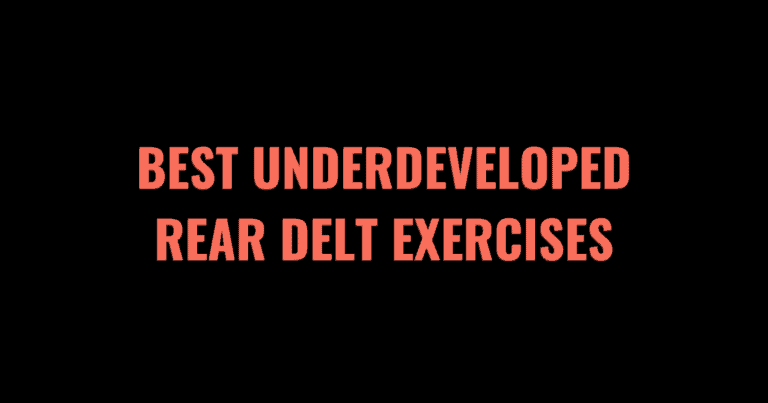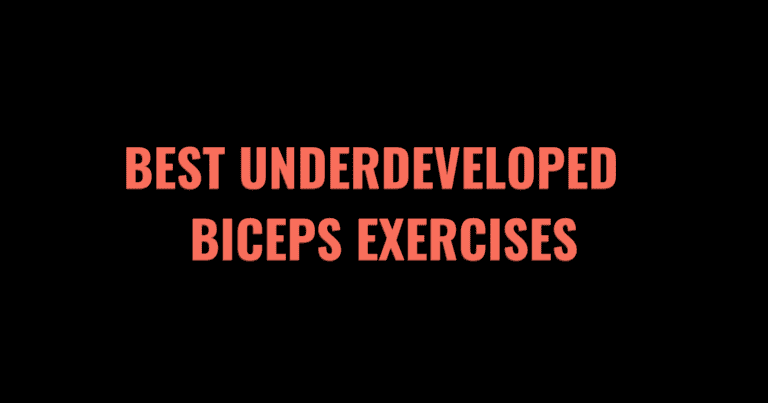A common saying in the fitness industry is that “abs are made in the kitchen.” Essentially, your diet is the key to getting a 6-pack. Although you must be lean to have visible abs, building and strengthening your abs will help them stand out even at a higher body fat percentage.
It’s quite common for people to train their core by only performing bodyweight exercises and doing an absurd number of repetitions. However, the core, more specifically the rectus abdominals, is like any other muscle. You need to progressively overload your abs to grow and get stronger.
A chiseled midsection is impressive from an aesthetics standpoint, but it’s also important for performance, especially if you are an athlete. The strong core plays a vital role in nearly every movement and will make a big difference inside and outside the gym.
A weak core drastically increases your risk for injury and negatively impacts your ability to do various tasks. If you’ve noticed that any area of your core is underdeveloped based on strength, stability, or muscular development, it’s a good idea to address that as soon as possible.
If your upper abs lag behind, you’ve come to the right place! This article specifically focuses on improving underdeveloped upper abs. Increasing the size and strength of your upper abs will enhance your aesthetics and performance. Keep reading to see what are the best training tactics to get your upper abs to respond!
Table of Contents
- 1 What are underdeveloped upper abs?
- 2 The 8 Best Ways to Grow Bigger Upper Abs
- 2.1 Perform 4-15 sets of direct upper ab work per week
- 2.2 Directly train the upper abs 2-4 times per week
- 2.3 Train with the right amount of intensity
- 2.4 Ensure proper exercise technique
- 2.5 Use a full range of motion
- 2.6 Train your abs near the beginning of the workout
- 2.7 Implement an exercise tempo
- 2.8 Periodize your rep ranges
- 3 The 9 best upper ab exercises
- 4 Upper Abdominal Muscle Anatomy
- 5 Abdominal Hypertrophy Frequently Asked Questions
- 6 Final Thoughts
- 7 Grow Underdeveloped Muscle Groups
- 7.1 The 8 Best Ways to Build an Underdeveloped Core
- 7.2 The 7 Best Ways to Grow Underdeveloped Obliques
- 7.3 The 8 Best Ways to Grow Bigger Shoulders
- 7.4 The 8 Best Ways to Grow a Bigger Lower Chest
- 7.5 The 8 Best Ways to Strengthen Abs
- 7.6 The 8 Best Ways to Grow a Bigger Back
- 7.7 The 7 Best Ways to Grow Bigger Rear Delts
- 7.8 The 8 Best Ways to Grow Bigger Hamstrings
- 7.9 The 8 Best Ways To Grow a Bigger Upper Chest
- 7.10 The 8 Best Ways to Grow Bigger Biceps
- 7.11 The 5 Best Ways to Grow Bigger Triceps
- 7.12 The 8 Best Ways to Grow Bigger Front Delts
- 7.13 The 8 Best Ways to Grow Bigger Traps
What are underdeveloped upper abs?
Underdeveloped upper abs occur when the upper part of your midsection is noticeably weaker and/or smaller than the rest of the core or upper body. The best way to improve underdeveloped upper abs is by increasing the weekly volume, frequency, and/or intensity of direct upper ab exercises.
There are various muscle groups that make up the core, such as the rectus abdominus, obliques, and transverse abdominus. Each section of the core performs a different action. So if you want to target a specific core muscle, it’s important to choose the right exercise.
The upper abs are part of the rectus abdominus, which are the most superficial, so they really stand out when they are developed. Below you will find the most efficient training methods to improve your upper abs and the best exercises to perform.
The 8 Best Ways to Grow Bigger Upper Abs
- Perform 4-15 sets of direct upper ab work per week
- Directly train the abs 2-4 times per week
- Train with the right amount of intensity
- Ensure proper exercise technique
- Use a full range of motion
- Train your abs near the beginning of the workout
- Implement an exercise tempo
- Periodize your rep ranges
Here are the 8 best ways to improve underdeveloped upper abs:
Perform 4-15 sets of direct upper ab work per week
One factor that dictates how much muscle growth you achieve is weekly training volume. Training volume is normally described as the number of hard sets you do for a specific muscle group. Although there are some general recommendations for optimal weekly training volume, it depends on the individual and the muscle group.
For example, the abs don’t need any direct work to maintain their current size and strength. But if your goal is upper ab hypertrophy, some direct core work is necessary. According to Renaissance Periodization’s Ab Growth Training Tips Guide, performing at least 4 sets of direct ab work per week is the minimum amount you need to stimulate hypertrophy.
On the other hand, performing more than 20-25 sets per week is counterproductive. Most people will respond best to doing 4-15 sets of direct ab work. The optimal training volume is also based on how many times you train the muscle group each week, which is known as training frequency!
Directly train the upper abs 2-4 times per week
Some evidence suggests that doing more than 10-12 sets for any muscle in a single training session is not ideal because extra sets don’t contribute to the hypertrophic stimulus. Instead, they negatively affect your ability to recover. Performing more sets than needed is considered to be junk volume.
Even if your abs can handle more than 10-12 sets of direct ab work per week and you can only train them once per week, it’s not a good idea to exceed that in a single training session. Therefore, if your training volume for any specific muscle needs to exceed 10-12 sets to make progress, it’s best to train that muscle group more than once per week.
According to Renaissance Periodization’s Ab Growth Training Tips Guide, the optimal training frequency for upper abs is 2-4 times per week. The best training frequency for you will ultimately be determined by your schedule. Since ab exercises aren’t that demanding, you can easily add a few ab exercises to any workout. Training the upper abs at least twice weekly is feasible for most people. As your training frequency increases, adjust your training intensity to be able to recover between sessions.
Train with the right amount of intensity
Regarding hypertrophy, training intensity refers to how close you are to technical failure. Technical failure is when you cannot perform another repetition with good technique. Using technical failure as a guide instead of muscular failure is better for most people because it helps reduce the risk of injury and ensure proper form.
Research shows that training to failure isn’t necessary for muscle growth. In fact, leaving 1-3 reps in the tank is likely better because you have more energy for the following sets and exercises. Simply put, if you train to complete failure in the first set of the first exercise, you won’t be able to perform as well for the rest of the training sessions. If you train to failure, save it for the last set of the last exercise.
Training intensity for hypertrophy is typically prescribed using an RIR (reps in reserve) or RPE (rating of perceived exertion) scale. If your program shows an RIR of 2 reps or an RPE of 8, stop 2 reps shy of technical failure. In other words, you could perform another 2 reps before your form starts to break down.
Using a proper amount of intensity is crucial for hypertrophy. It ensures that you are training hard enough but not too hard to the point where you can’t recover and get injured or burnout. To a certain extent, training too hard is just as detrimental as not training hard enough. So if you are constantly training to failure or stopping every set of 4-5 reps from failure, you’re doing yourself a disservice.
Ensure proper exercise technique
To assess your training intensity accurately, base it on your exercise technique. This tactic allows you to judge how close you truly are to technical failure.
Stop the set as soon as you notice that you cannot perform the exercise based on the standard you’ve established. Good exercise technique is critical for preventing injuries and engaging the target muscles.
Exercise form is especially important for upper ab exercises, such as crunches and sit-ups, because it’s quite easy to cheat using momentum or other muscle groups. For example, the hip flexors tend to take over during ab exercises, so there’s less tension on the abdominals.
When performing any exercise, aim to limit the involvement of other muscle groups and maximize the recruitment of the target muscle group(s). You can assess your exercise technique by recording yourself and rating your mind-muscle connection. In other words, if you don’t feel the abs working, you’re probably not doing the exercise correctly.
Use a full range of motion
Working through a full range of motion goes hand in hand with proper exercise technique. When performing ab exercises, such as machine crunches, weighted crunches, or sit-ups, focus on performing full spinal flexion and extension.
This attention ensures that the abdominals completely stretch and contract. If you’re performing crunches, use an exercise ball or ab mat to allow for greater spinal extension.
It’s quite common for people to cut the range of motion short when performing ab exercises just so they can complete the reps faster and/or use more weight. In reality, they are cutting their ab hypertrophy short.
Instead, it’s better to work through a full range of motion and control the movement, even if that means you have to lower the weight or scale the exercise. Improving your range of motion usually results in more hypertrophy and strength gains over time.
Train your abs near the beginning of the workout
Since the abs are a smaller muscle group; ab exercises are normally added at the end of a workout. One of the best ways to prioritize a muscle group is by training it at the beginning of the workout.
You have more energy at the start of a training session, and you’re less likely to skip out on the ab exercises. This may seem like a small change, but it can significantly impact your upper abdominal muscle development.
Although the core is involved in several compound movements, training your abs at the start of a workout shouldn’t negatively affect your performance on subsequent exercises. As you increase your training frequency and abdominal volume, add in a few ab exercises to the start of a workout.
Implement an exercise tempo
In some contexts, it’s more important to be explosive, such as in powerlifting or Olympic weightlifting. However, when it comes to hypertrophy, it’s more optimal to control the repetitions rather than do them as fast as possible. Implementing an exercise tempo can be very beneficial.
An exercise tempo is usually noted with a 3 or 4-digit code, such as 3-1-2-0. The first number represents the lowering or eccentric portion of the exercise. The second number represents how long you should pause at the top of the exercise. The third number represents the lifting or concentric portion of the exercise. The last number represents how long you should pause at the bottom of the exercise.
If you apply the 3-1-2-0 tempo to a decline sit-up, here’s what that would look like:
- It should take you ~2 seconds to go from the starting position to full spinal flexion.
- Pause at the top and squeeze the abs for 1 second at the top of each repetition.
- It should take you ~3 seconds to return to the starting position.
- Don’t pause at all between repetitions; immediately start the next rep.
Controlling the eccentric portion typically leads to more muscle growth because there’s more time under tension on the target muscle group. Furthermore, controlling the movement using an exercise tempo reduces the risk of injury. If you cannot perform the movement with the prescribed exercise tempo, you may have to lower the weight or make the exercise easier.
Periodize your rep ranges
Like any other muscle group; the abs need progressive overload to grow and strengthen. Many people tend to train the abs using no weight and high amounts of reps for fear that their waist will get too bulky. However, doing 100 reps of crunches is both time-consuming and ineffective for most people.
The abs respond best to rep ranges between 5-30 reps, with the sweet spot being 10-20 reps. Since the abs are made up of fast and slow twitch muscle fibers, it’s good to vary your rep ranges periodically.
If you go through a period of training the abs in the 8-10 rep range, you will most likely have to add weight to obtain the proper exercise intensity. In contrast, when you perform 15-20 reps, your body weight may be challenging enough.
Lastly, aim to switch up your rep range and exercise selection every 4-6 weeks. It’s important to note that the abs will respond if you are training close enough to failure.
The 9 best upper ab exercises
Here are some of the best upper ab exercises:
- Cable crunches
- Machine crunches
- Bodyweight crunches
- Weighted crunches
- Decline sit-ups
- Barbell rollout
- Stability ball crunch
- Hallow body hold
- Plank
Upper Abdominal Muscle Anatomy
The upper abdominals are part of the rectus abdominis muscle, which runs from the sternum to the pelvis. The rectus abdominis is just one of the core muscles. Other major core muscles include the transverse abdominis, external obliques, and internal obliques.
The rectus abdominis is the most superficial ab muscle, making up the 6-pack that most gym-goers are after. The upper abs are typically easier to reveal than the lower abs because you’re less likely to store body fat in that area.
The rectus abdominis is primarily responsible for spinal flexion and stabilization. The upper abs are recruited the most when the sternum is brought closer to your pelvis such as during a crunch or sit-up.
Abdominal Hypertrophy Frequently Asked Questions
Can you isolate the upper abs?
Unfortunately, it’s not possible to completely isolate the upper abs. It is possible to emphasize them by performing certain exercises. The upper abs are most engaged during spinal flexion, especially when the sternum moves closer to the pelvis.
If you want to emphasize your upper abs over the rest of the core, doing more crunches and sit-ups is a good idea. The upper abs are still engaged during other ab exercises but not to the same extent. It’s also not possible to correct uneven abs by training them; the shape of your abdominal muscles is determined by your genetics.
Is direct ab training necessary?
If you want to maintain the size and strength of your core, direct ab training is not necessary as long as you perform other compound movements, such as squats, deadlifts, and overhead presses. Since the abs are recruited during various other exercises, they get enough stimulus to maintain their current size and strength.
However, direct ab training is necessary if your goal is to get stronger and more visible abs. If you rely on compound movements to build your abs, you will most likely be disappointed by the results.
How do you get visible abs?
A common saying in the fitness industry is that “abs are built in the kitchen.” In reality, abs are built in the gym and revealed in the kitchen. In other words, you need to train your abs in the gym and eat a proper diet to reveal what you have built. No matter how impressive your abs are, if you are above 20% body fat, it’s unlikely that you will see them. Obtaining low body fat plays a part in getting six-pack abs.
On the other hand, if you have to get extremely lean to see your abs and they aren’t that impressive, you could benefit from building them. Having more developed abs gives you the illusion that you are leaner than you are because they stand out even at a higher body fat percentage.
What type of exercise targets the upper abs?
The main function of the upper abs is spinal flexion, so the exercises that target the upper abs the most are weighted crunches, machine crunches, hanging leg raises, and decline sit-ups. The upper abs also stabilize the spine, so they are recruited during planks, hollow body holds, and barbell roll-outs.
Final Thoughts
The abdominal muscles are like any other muscle group; you need to train them with the proper amount of frequency, volume, and intensity to make them stronger and bigger. Doing high reps with little to no rest between sets is not the optimal way to train your abs.
Start with 4-6 sets of ab exercises per week divided amongst 1-2 days per week and increase as necessary to continue to see results. If you really want six-pack abs, spend a significant period of time building your abs and dial in your diet to reveal them. You will have a stronger and more impressive core in no time.
Grow Underdeveloped Muscle Groups
If you enjoyed this post, check out our other guides on how to grow lagging muscle groups.
